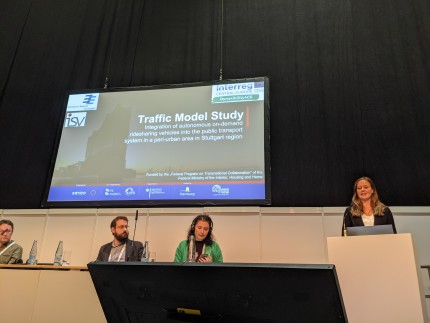Efforts of Stuttgart recognised as Interreg best practice
Our project partner ‘Verband Region Stuttgart‘ was invited to showcase their local actions in the framework of Dynaxibility4CE. These are related to an autonomous ride-sharing service for the peri-urban area, which has the potential to be integrated into the public transport system of the metropolitan region of Stuttgart. You can find the full news item on the dedicated best practices page of the ‘Land Baden-Württemberg’ in German.
Exiting your home by hopping into a bus or metro, which arrives in an interval of at least five minutes, and brings you safely to the city centre, the next train station, or the airport: this is an example how efficient and sustainable local public transport could work. However, this is mostly the case in predominantly urban and metropolitan areas and much less in the peri-urban areas around them.
Stuttgart, however, is already a step ahead in this respect. Thanks to the Dynaxibility4CE project, a transport modelling exercise has been started, which combines classic public transport services, which follow specific routes, with new mobile developments in the 'Schurwald region' in the East of Stuttgart. Until now, people in the region have had to rely on buses as a feeder service, which cannot always offer a precise connection to suburban or regional trains. Therefore, many citizens are still prone to use their own car. The new solution in the Dynaxibility4CE framework enables users to select between different transport offers and last mile solutions.

Nadine Müller, Verband Region Stuttgart, presented local Dynaxibility4CE results during session at ITS World Congress Hamburg 2021.
The idea is to meet the demand in transport modelling flexibly with 6-seater ride-sharing shuttles, which are connected and fully autonomous (level 5). ‘The Stuttgart region and the history of the car are strongly intertwined from the very beginning. We not only want to be developers from the horse-drawn carriage to the car, but also to be pioneers in autonomous driving’, says Dr. Nicola Schelling, regional director of the Verband Region Stuttgart. ‘As the responsible body for the of the metro, it is our concern that autonomous driving is taking the form of on-demand services, which allows users to car-pool’.
The efficient integration of the autonomous ride-sharing service into a network in which the individual modes of transport are flexibly aligned to a wide variety of requirements is expected to be very user-friendly. Frieder Oesterle, European coordinator at the Verband Region Stuttgart, and Nadine Müller, transport planner, are the experts behind the project implementation in Stuttgart. ‘We are realising a microscopic adaptation of the existing traffic model’, explains Oesterle. ‘The Schurwald is a perfect example for the greater Stuttgart area, as we map the municipalities in traffic cells in the regional traffic model to be able to specify demand effects of the new transport offer on the population’.
Thanks to the expertise of the University of Stuttgart, the model was created in an efficient way, which resulted in an action plan. Based on these experiences, the region of Stuttgart hopes for a pilot project to put the theoretical approach into practice. For example, the local districts of Böblingen and Ludwigsburg have applied for funding to offer on-demand services in peri-urban areas. Even though these are not yet completely autonomous, they will provide important results and improvements for public transport services.
